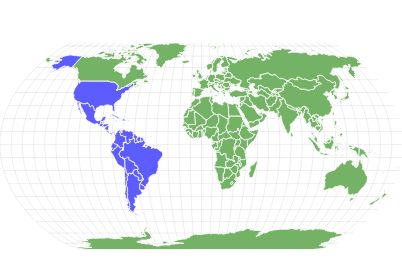Hummingbird
Hummingbird eggs are just half an inch big.
Advertisement
Hummingbird Scientific Classification
Read our Complete Guide to Classification of Animals.
Hummingbird Conservation Status
Hummingbird Facts
- Main Prey
- Nectar, Tree sap, Insects, Spiders
- Fun Fact
- Hummingbird eggs are just half an inch big.
- Distinctive Feature
- Long, thin beak and the ability to hover
- Wingspan
- Three to five inches
- Incubation Period
- 15 to 18 days
- Habitat
- Rainforest and tropical jungles
- Predators
- Hawks, Snakes, Lizards
- Diet
- Omnivore
- Lifestyle
- Solitary
- Favorite Food
- Nectar
- Type
- Bird
- Average Clutch Size
- 2
- Slogan
- Beat their wings up to 80 times per second!
- Nesting Location
- Sheltered trees or shrubbery and fork of branches
- Age of Molting
- Four months for some species
- Migratory
- 1
View all of the Hummingbird images!
The hummingbird is small in size — usually only about 7.5 to 13 centimeters in length.
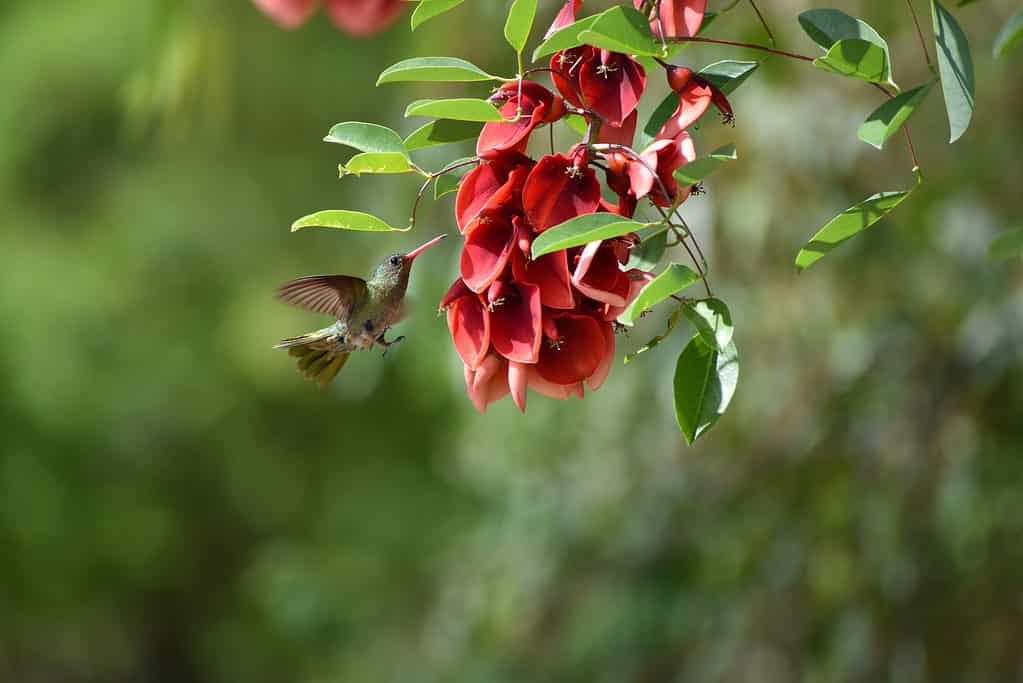
This gilded sapphire (Hylocharis chrysura), or gilded hummingbird, is barely larger than the blossoms of ceibo tree (Erythrina crista-galli).
©iStock.com/Christian Peters
Native to the Americas, hummingbirds largely form the family called Trochilidae, which is also their scientific name. There are about 350 different known species of hummingbirds including the bee, anna, ruby-throated, and topaz. However, the list keeps on updating each year as variations are discovered.
The smallest of the hummingbird – which is the bee hummingbird – weighs just about 2 grams. Two species of these birds have now known to have gone extinct. They are also famous for their ability to fly backwards.
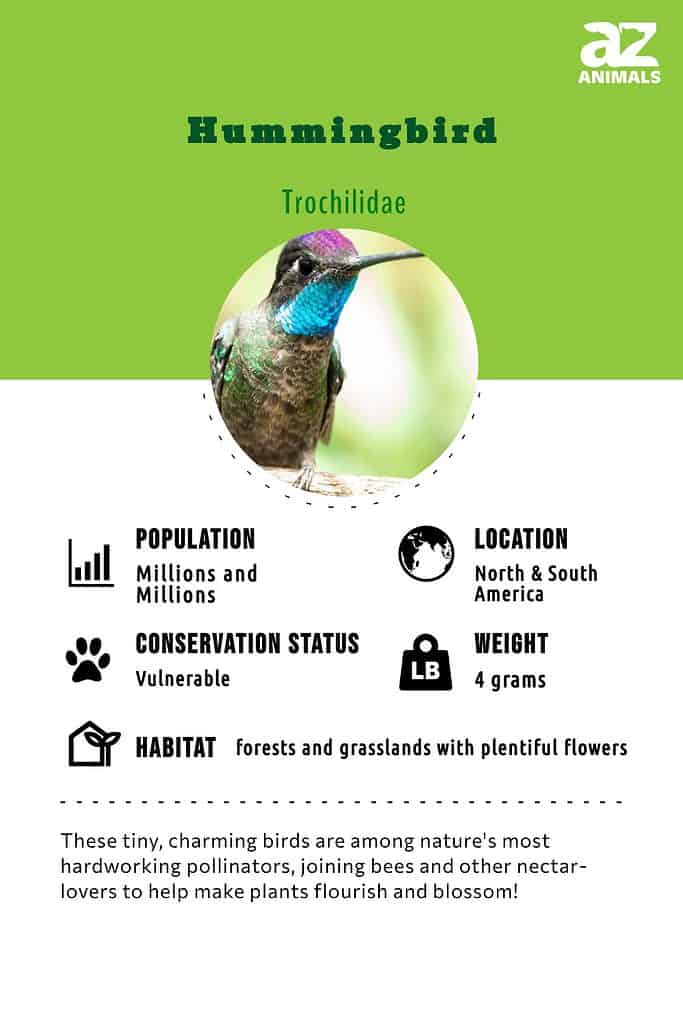
An Amazing Bird: 5 Hummingbird Facts
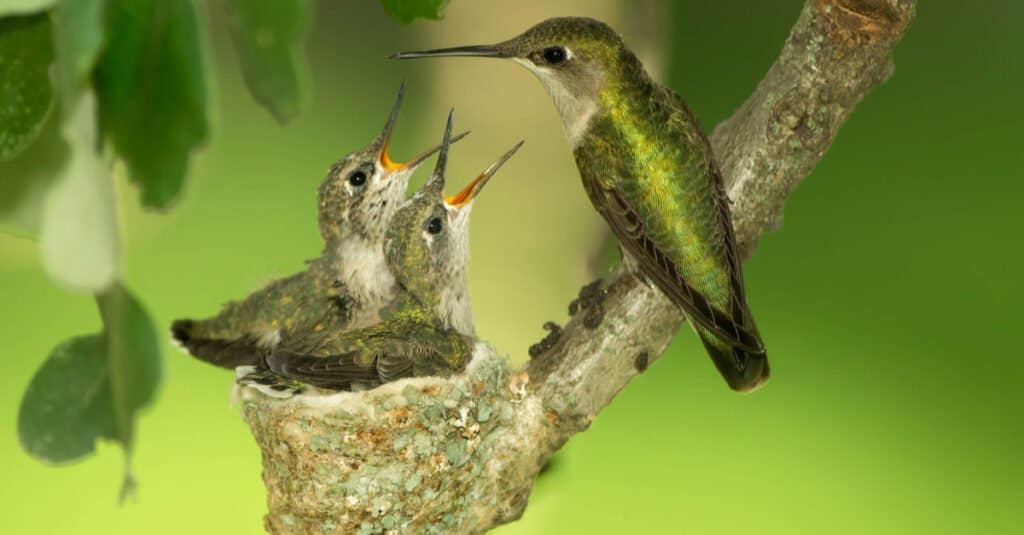
Two hungry baby hummingbird chicks eagerly welcome the arrival of their mother.
©Agnieszka Bacal/Shutterstock.com
- Their average clutch size is no more than three eggs, but a female will have one or two broods. The eggs are just half an inch big, and the mother needs to take care of the eggs for about two weeks before they hatch.
- Hummingbirds are the only birds that can fly backwards, thanks to a wingspan that can exceed their full length by at least one-fourth of an inch.
- They get their name from the humming sound that their wings make when they flap together quickly.
- On average, a hummingbird weighs even less than a nickel. The bee hummingbird, in fact, only weighs 2 grams at its adult size.
- While hummingbirds aren’t especially heavy, they can be quite large. The largest hummingbird in the world measured more than 9 inches in length!
Read more incredible facts about hummingbirds here.
Where to Find Hummingbirds
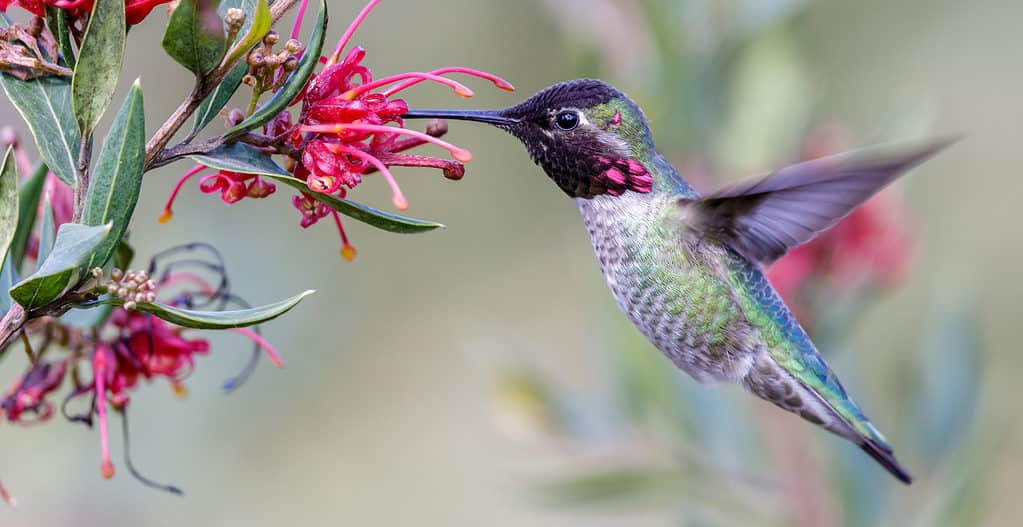
Calypte anna is just one of 340 species of hummingbird found across North America.
©yhelfman/Shutterstock.com
Bird watchers are in luck – hummingbirds can be sighted in a variety of places, spanning across the Americas. However, even among the 340 different species, these birds are not located beyond the New World, so you might need to travel if you are in the Eastern Hemisphere.
Different types of these birds, like bee, anna, topaz, and ruby-throated hummingbirds are found in different parts of the world. The easiest way to find one of these unique and special birds is to get closer to the equator, since these birds like the warmth. With over half of the known species that live right along the equator, you can still spot them above Mexico.
Some of the places where these small birds are found include the Southwestern states such as California, Arizona, Texas, and New Mexico. In these places, areas like the Davis Mountains State Park in Texas and/or the Ramsey Canyon Preserve in Arizona are popular hotspots for hummingbird sightings.
Scientific Name
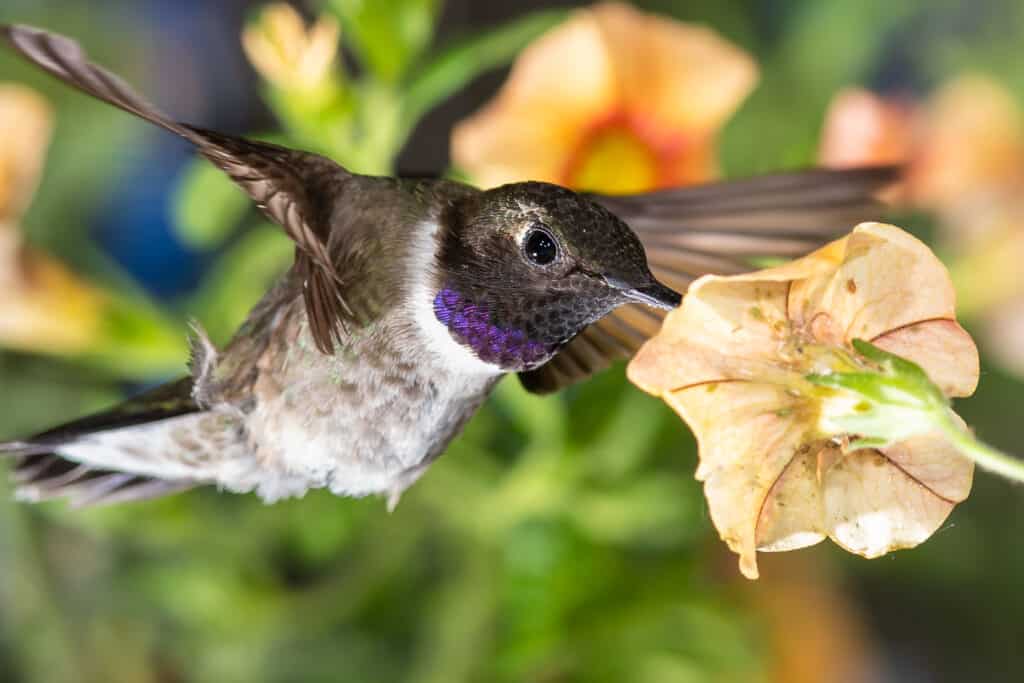
Trochilidae is the hummingbird’s scientific name.
©rck_953/Shutterstock.com
These birds go by the scientific name Trochilidae and belong to a family that goes by the same name. They belong to the kingdom Animalia and Phylum Chordata. Their class is called Aves and the order is called Apodiformes.
Trochilidae is rooted in a Greek word – trochilos – which is interpreted to mean “a small bird” by some sources. However, it can also be traced to the Ancient Greek word τροχίλος, which means “Egyptian plover.” A plover is a wading bird that is rather stout with a short bill, which is much different than a hummingbird.
Size, Appearance, and Behavior
These birds are small in size. Even the largest of these birds – the Patagona gigas in South America – is only about 8 inches long. Different hummingbirds, however, come in different sizes. The calliope hummingbird is three inches long, while the bee hummingbird is 2.25 inches long. Meanwhile, Topaz hummingbirds are 3.1 to 3.5 inches long.
These birds look slightly different than normal birds, which is part of their beauty. Despite their streamlined stubby bodies, they have gracefully long bills and wings. While their extremely tiny legs can make it difficult to walk around, they don’t need to – their wings move about 10-15 times per second, allowing them to hover in place.
This incredible speed is only one way that their flying is both unusual and captivating. The power of their wings makes them the only birds that can fly backward. In the blink of an eye, they can change directions, seeming to hover in the air. If they so choose, the bird is even capable of flying upside down.
These birds are known to be aggressive birds and often shoo the intruders away. They are among some of the fiercest birds which often seems contradictory to their tiny size. They not only successfully drive away large birds but can attack other animals and even human beings.
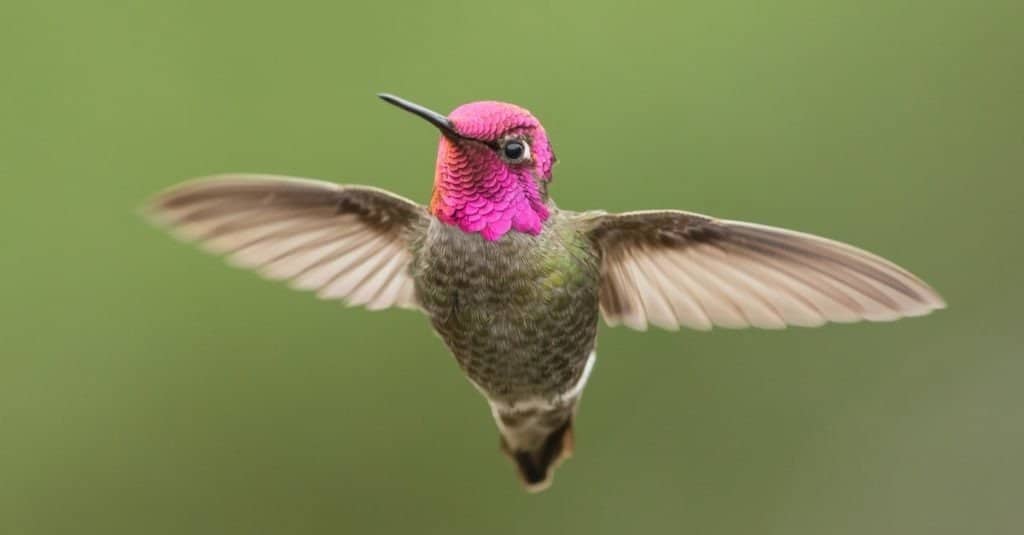
This hummingbird is displaying its incredible ability to hover in midair.
©Keneva Photography/Shutterstock.com
Diet
The bird’s diet includes consuming half of their own weight worth of sugar, which why sugar water is the easiest way to attract them to a bird feeder. These birds feed themselves about five to eight times per day, also finding this sugar from nectar and fruit.
When they aren’t grazing on sugar, sugar water, or natural nectar, the hummingbird will also seek out insects and invertebrates as nourishment. Their preferred diet consists of ants, spiders, beetles, mosquitos, gnats, weevils, fruit flies, and aphids, making them ideal guests around any home. In a pinch, they’ll also find whatever food is captured in spider webs. For a complete list of foods hummingbirds eat, check out our “What Do Hummingbirds Eat?” page.
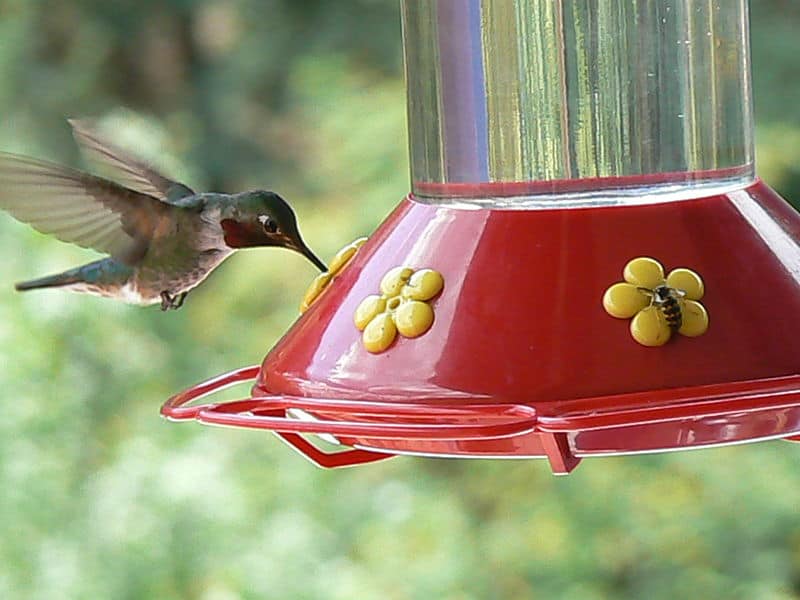
Hummingbird feeders are a great way to invite them into your own backyard!
©Garrett Davis – Public Domain
Predators and Threats
These birds, especially owing to their tiny size, have a lot of predators, which may be why they have to be so aggressive to defend themselves. Their eggs are at constant risk of falling victim to predators, though one of their biggest threats is that of humans.
As cities become more urbanized, the natural habitats of these animals dwindle. Deforestation is a major problem for hummingbirds, but the average bird enthusiast can contribute by adding a hummingbird feeder and ample foliage around their yard to attract the birds for a place to build a nest and eat.
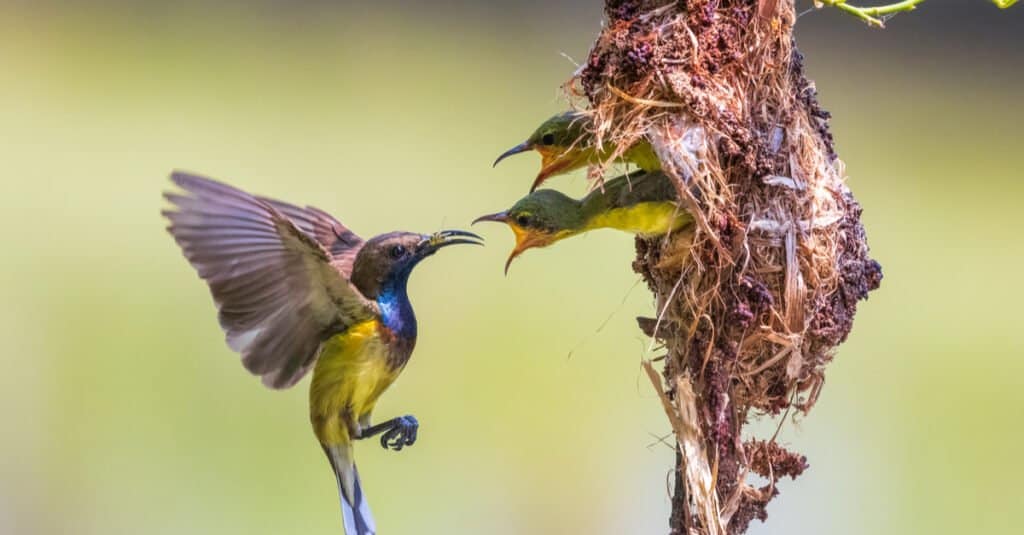
A typical hummingbird nest is built out of scavenged local foliage.
©ukrit.wa/Shutterstock.com
What eats hummingbirds?
These birds are in constant peril as they avoid the clutches of frogs, snakes, lizards, squirrels, chipmunks, blue jays, crows, and other aggressive birds.
Their eggs need special attention to avoid predators as well. Even once hatched, the eggs and young are sought out by blue jays, squirrels, chipmunks, and crows.
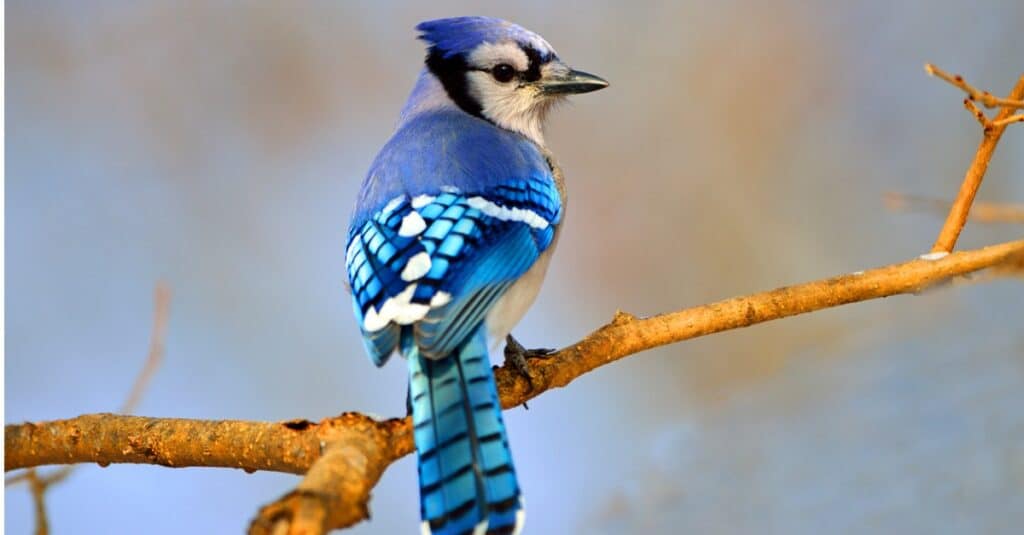
The blue jay is one of the hummingbird’s fiercest predators.
©iStock.com/BrianEKushner
What do hummingbirds eat?
Hummingbirds usually feed on the nectar from flowers, as well as broken fruit that they can source natural sugar from. While they will go after small insects, these birds aren’t much of a predator. The only time they will go after any game bigger than a spider or beetle is if they feel threatened, but only to defend themselves (not to eat).
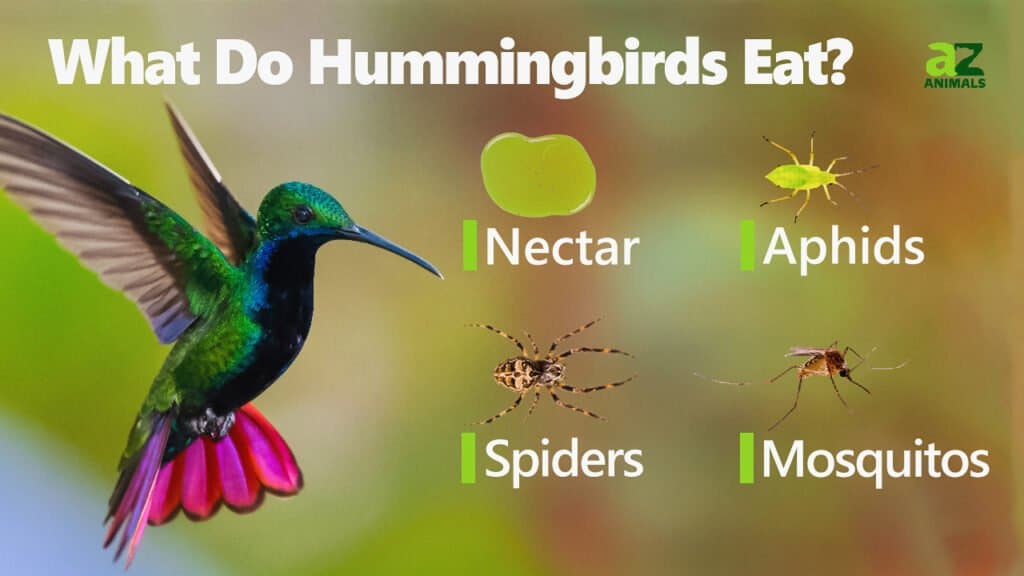
Reproduction, Babies, and Lifespan
Hummingbirds start mating when they are one year of age. Every year, female hummingbirds can raise up to three baby broods – which means six baby hummingbirds per year.
Before mating, a male hummingbird has to convince the female hummingbird that he would be a perfect match for her. For that reason, the males tend to be a little more colorful, which is a natural evolutionary trait of most bird species.
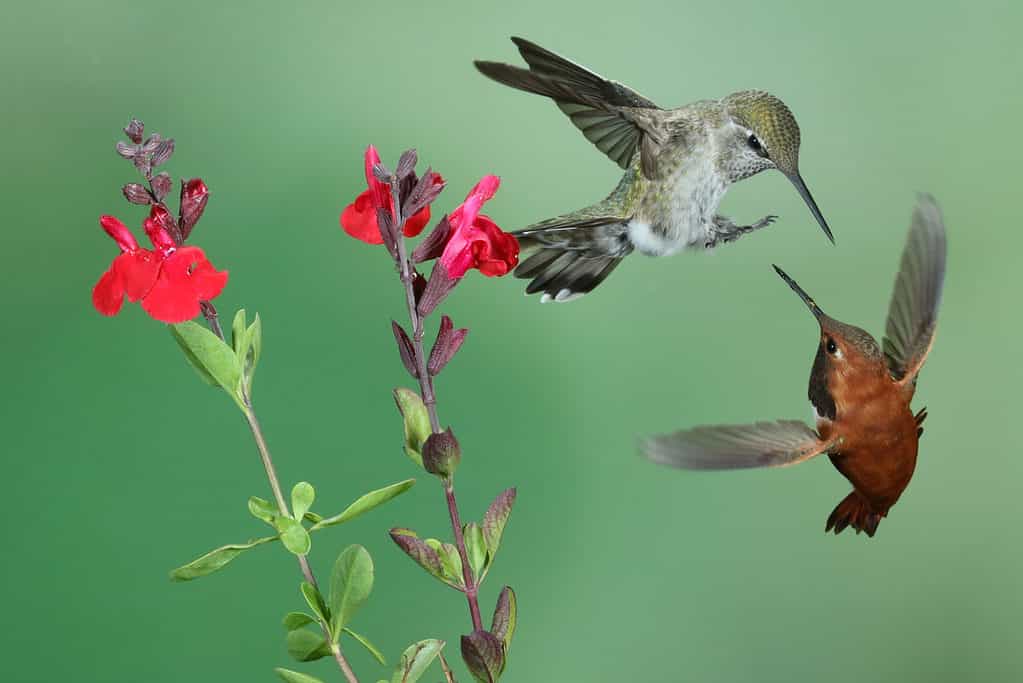
This Annas Hummingbird uses their vibrant colors to help attract a potential mate.
©iStock.com/Jedlovec
Female hummingbirds are known to be solitary mothers; after impregnating the female, males move on with their lives. She stays behind to lay her eggs, incubating them for about two weeks. The eggs are about the size of navy beans. Typically, during one breeding session, female hummingbirds usually lay only two eggs.
Their young – which are called chicks – will remain in the nest as their mother nurtures and feeds them for up to four weeks after birth. The lifespan of hummingbirds is about three to five years.
Evolution
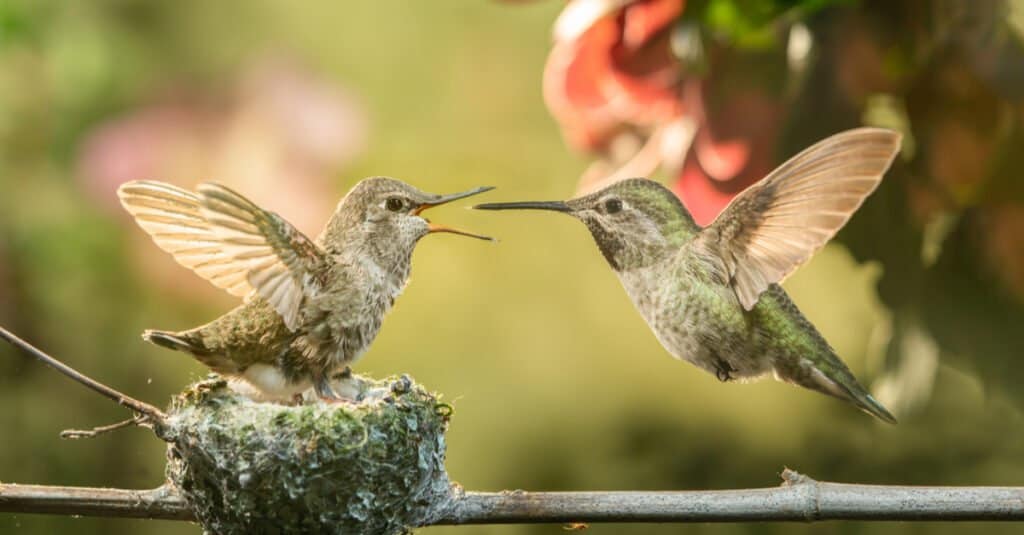
Hummingbirds have evolved to be some of the avian world’s most gifted flyers.
©Freebilly Photography/Shutterstock.com
Scientists were absolutely baffled when they discovered the oldest known hummingbird fossil, which dated back to 30 million years ago, not because of its age, but the location: Southern Germany! This proved to biologists that Hummingbirds had not always been native to solely the Americas.
It is believed that about 40 million years ago hummers began to take on traits unique to their closest relative, the swift, and around 20 million years ago migrated to South America and began to co-evolve with local flowers. There is much speculation regarding the specifics of how hummingbirds became the endearing pollinators we know today as there is a massive gap in the fossil record, with the oldest North American Hummingbird fossils being only less than 10,000 years old. Until more data can be collected, all we can do is hypothesize as to how these marvels of nature came to be.
Population
While the exact population of hummingbirds is not known, some species of hummingbirds like the ruby-throated hummingbirds are as many as 34,000,000 in number according to an official American survey. There are over 300 different species, though about half of the birds live along the equator.
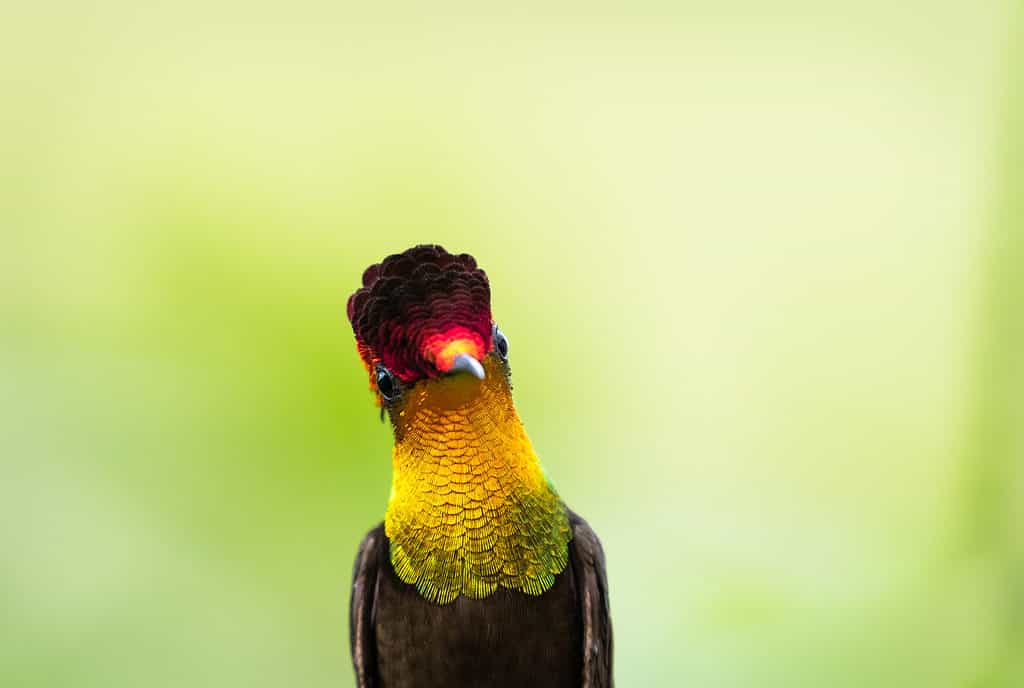
Closeup of the Ruby Topaz hummingbird, Chrysolampis mosquitus, with glittering gold and red feathers.
©iStock.com/Chelsea Sampson
Types of Hummingbirds
There are currently 366 different species of hummingbirds recognized by the International Ornithological Committee. You can find a comprehensive list of every kind of hummingbird and their scientific name below!
- Crimson Topaz: Known by the scientific name Topaza pella, this hummingbird is native to Venezuela, Suriname, Guyana, French Guiana and Brazil.
- Fiery Topaz: Topaza pyra is the scientific name of this hummingbird. It lives in Northern South America.
- White-necked Jacobin: Florisuga mellivora is the scientific name for this brilliant blue and white hummingbird. It can be found in Mexico and other parts of Central America.
- Black Jacobin: The Florisuga fusca is a common sight among coffee and cacao plantations of Uruguay, Paraguay, Brazil, and Argentina.
- White-tipped Sicklebill: The Eutoxeres aquila is only about 12 cm long.
- Buff-tailed Sicklebill: Eutoxeres condamini is a close relative of the White-tipped Sicklebill.
- Saw-billed Hermit: Known by the scientific name Ramphodon naevius, this hummingbird lives in the rainforests of Brazil.
- Hook-billed Hermit: Glaucis dohrnii is a rare hummingbird only found in a small region of Brazil.
- Bronzy Hermit: Glaucis aeneus is native to Panama, Nicaragua, Honduras, Ecuador, Costa Rica and Colombia.
- Rufous-breasted Hermit: The Glaucis hirsutus is also known as the “hairy hermit.”
- Band-tailed Barbthroat: Threnetes ruckeri can be found throughout much of South and Central America.
- Pale-tailed Barbthroat: Threnetes leucurus inhabit a wide area of the Amazon.
- Sooty Barbthroat: Threnetes niger was first described by Taxonimist Carl Linnaeus in 1758.
- Broad-tipped Hermit: Anopetia gounellei is one of many species of hummingbird found only in Brazil.
- Dusky-throated Hermit: Phaethornis squalidus is a hummingbird with a nuanced and complex song native to Brazil.
- Streak-throated Hermit: Phaethornis rupurumii is sometimes known as the Rupurumi Hermit.
- Little Hermit: Phaethornis longuemareus is one of the tiniest hummingbirds, weighing less than 0.12 oz.
- Tapajos Hermit: This hummingbird is known by the scientific name Phaethornis aethopygus
- Minute Hermit: Phaethornis idaliae is the scientific name of this Brazillian hummingbird.
- Cinnamon-throated Hermit: Bolivia and Brazil are home to the Phaethornis nattereri.
- Black-throated Hermit: Phaethornis atrimentalis can be found in Colombia, Ecuador and Peru.
- Stripe-throated Hermit: Phaethornis striigularis is a very common hummingbird throughout South and Central America.
- Grey-chinned Hermit: Phaethornis griseogularis live in Venezuela, Peru, Ecuador, Colombia, and Brazil.
- Reddish Hermit: Phaethornis ruber
- White-browed Hermit: Phaethornis stuarti
- Buff-bellied Hermit: Phaethornis subochraceus
- Sooty-capped Hermit: Phaethornis augusti
- Planalto Hermit: Phaethornis pretrei
- Scale-throated Hermit: Phaethornis eurynome
- Pale-bellied Hermit: Phaethornis anthophilus
- White-bearded Hermit: Phaethornis hispidus
- White-whiskered Hermit: Phaethornis yaruqui
- Green Hermit: Phaethornis guy
- Tawny-bellied Hermit: Phaethornis syrmatophorus
- Koepcke’s Hermit: Phaethornis koepckeae
- Needle-billed Hermit: Phaethornis philippii
- Straight-billed Hermit: Phaethornis bourcieri
- Mexican Hermit: Phaethornis mexicanus
- Long-billed Hermit: Phaethornis longirostris
- Long-tailed Hermit: Phaethornis superciliosus
- Great-billed Hermit: Phaethornis malaris
- Green-fronted Lancebill: Doryfera ludovicae
- Blue-fronted Lancebill: Doryfera johannae
- White-throated Daggerbill: Schistes albogularis
- Geoffroy’s Daggerbill: Schistes geoffroyi
- Hyacinth Visorbearer: Augastes scutatus
- Hooded Visorbearer: Augastes lumachella
- Brown Violetear: Colibri delphinae
- Mexican Violetear: Colibri thalassinus
- Lesser Violetear: Colibri cyanotus
- Sparkling Violetear: Colibri coruscans
- White-vented Violetear: Colibri serrirostris
- Tooth-billed Hummingbird: Androdon aequatorialis
- Horned Sungem: Heliactin bilophus
- Purple-crowned Fairy: Heliothryx barroti
- Black-eared Fairy: Heliothryx auritus
- White-tailed Goldenthroat: Polytmus guainumbi
- Tepui Goldenthroat: Polytmus milleri
- Green-tailed Goldenthroat: Polytmus theresiae
- Fiery-tailed Awlbill: Avocettula recurvirostris
- Ruby-topaz Hummingbird: Chrysolampis mosquitus
- Jamaican Mango: Anthracothorax mango
- Green-throated Mango: Anthracothorax viridigula
- Green-breasted Mango: Anthracothorax prevostii
- Veraguan Mango: Anthracothorax veraguensis
- Black-throated Mango: Anthracothorax nigricollis
- Hispaniolan Mango: Anthracothorax dominicus
- Puerto Rican Mango: Anthracothorax aurulentus
- Green Mango: Anthracothorax viridis
- Green-throated Carib: Eulampis holosericeus
- Purple-throated Carib: Eulampis jugularis
- Orange-throated Sunangel: Heliangelus mavors
- Amethyst-throated Sunangel: Heliangelus amethysticollis
- Longuemare’s Sunangel: Heliangelus clarisse
- Merida Sunangel: Heliangelus spencei
- Gorgeted Sunangel: Heliangelus strophianus
- Tourmaline Sunangel: Heliangelus exortis
- Flame-throated Sunangel: Heliangelus micraster
- Purple-throated Sunangel: Heliangelus viola
- Royal Sunangel: Heliangelus regalis
- Green-backed FIrecrown: Sephanoides sephaniodes
- Juan Fernandez Firecrown: Sephanoides fernandensis
- Green Thorntail: Discosura conversii
- Wire-crested Thorntail: Discosura popelairii
- Black-bellied Thorntail: Discosura langsdorffi
- Letitia’s Thorntail: Discosura letitiae
- Racket-tailed Coquette: Discosura longicaudus
- Tufted Coquette: Lophornis ornatus
- Dot-eared Coquette: Lophornis gouldii
- Frilled Coquette: Lophornis magnificus
- Short-crested Coquette: Lophornis brachylophus
- Rufous-crested Coquette: Lophornis delattrei
- Spangled Coquette: Lophornis stictolophus
- Festive Coquette: Lophornis chalybeus
- Butterfly Coquette: Lophornis verreauxii
- Peacock Coquette: Lophornis pavoninus
- Black-crested Coquette: Lophornis helenae
- White-crested Coquette: Lophornis adorabilis
- Ecuadorian Piedtail: Phlogophilus hemileucurus
- Peruvian Piedtail: Phlogophilus harterti
- Speckled Hummingbird: Adelomyia melanogenys
- Long-tailed Sylph: Aglaiocercus kingii
- Violet-tailed Sylph: Aglaiocercus coelestis
- Venezuelan Sylph: Aglaiocercus berlepschi
- Red-tailed Comet: Sappho sparganurus
- Bronze-tailed Comet: Polyonymus caroli
- Grey-bellied Comet: Taphrolesbia griseiventris
- Andean Hillstar: Oreotrochilus estella
- White-sided Hillstar: Oreotrochilus leucopleurus
- Ecuadorian Hillstar: Oreotrochilus chimborazo
- Blue-throated Hillstar: Oreotrochilus cyanolaemus
- Green-headed Hillstar: Oreotrochilus stolzmanni
- Black-breasted Hillstar: Oreotrochilus melanogaster
- Wedge-tailed Hillstar: Oreotrochilus adela
- Mountain Avocetbill: Opisthoprora euryptera
- Black-tailed Trainbearer: Lesbia victoriae
- Green-tailed Trainbearer: Lesbia nuna
- Black-backed Thornbill: Ramphomicron dorsale
- Purple-backed Thornbill: Ramphomicron microrhynchum
- Bearded Mountaineer: Oreonympha nobilis
- Buffy Helmetcrest: Oxypogon stuebelii
- Blue-bearded Helmetcrest: Oxypogon cyanolaemus
- White-bearded Helmetcrest: Oxypogon lindenii
- Green-bearded Helmetcrest: Oxypogon guerinii
- Bronze-tailed Thornbill: Chalcostigma heteropogon
- Rainbow-bearded Thornbill: Chalcostigma herrani
- Rufous-capped Thornbill: Chalcostigma ruficeps
- Olivaceous Thornbill: Chalcostigma olivaceum
- Blue-mantled Thornbill: Chalcostigma stanleyi
- Tyrian Metaltail: Metallura tyrianthina
- Perija Metaltail: Metallura iracunda
- Viridian Metaltail: Metallura williami
- Violet-throated Metaltail: Metallura baroni
- Neblina Metaltail: Metallura odomae
- Coppery Metaltail: Metallura theresiae
- Fiery-throated Metaltail: Metallura eupogon
- Scaled Metaltail: Metallura aeneocauda
- Black Metaltail: Metallura phoebe
- Greenish Puffleg: Haplophaedia aureliae
- Buff-thighed Puffleg: Haplophaedia assimilis
- Hoary Puffleg: Haplophaedia lugens
- Black-breasted Puffleg: Eriocnemis nigrivestis
- Gorgeted Puffleg: Eriocnemis isabellae
- Glowing Puffleg: Eriocnemis vestita
- Black-thighed Puffleg: Eriocnemis derbyi
- Turquoise-throated Puffleg: Eriocnemis godini
- Coppery-bellied Puffleg: Eriocnemis cupreoventris
- Sapphire-vented Puffleg: Eriocnemis luciani
- Golden-breasted Puffleg: Eriocnemis mosquera
- Blue-capped Puffleg: Eriocnemis glaucopoides
- Colorful Puffleg: Eriocnemis mirabilis
- Emerald-bellied Puffleg: Eriocnemis aline
- Marvelous Spatuletail: Loddigesia mirabilis
- Shining Sunbeam: Aglaeactis cupripennis
- White-tufted Sunbeam: Aglaeactis castelnaudii
- Purple-backed Sunbeam: Aglaeactis aliciae
- Black-hooded Sunbeam: Aglaeactis pamela
- Bronzy Inca: Coeligena coeligena
- Brown Inca: Coeligena wilsoni
- Black Inca: Coeligena prunellei
- Green Inca: Coeligena conradii
- Collared Inca: Coeligena torquata
- Gould’s Inca: Coeligena inca
- Violet-throated Starfrontlet: Coeligena violifer
- Rainbow Starfrontlet: Coeligena iris
- White-tailed Starfrontlet: Coeligena phalerata
- Dusky Starfrontlet: Coeligena orina
- Buff-winged Starfrontlet: Coeligena lutetiae
- Perija Starfrontlet: Coeligena consita
- Golden-bellied Starfrontlet: Coeligena bonapartei
- Golden-tailed Starfrontlet: Coeligena eos
- Blue-throated Starfrontlet: Coeligena helianthea
- Mountain Velvetbreast: Lafresnaya lafresnayi
- Sword-billed Hummingbird: Ensifera ensifera
- Great Sapphirewing: Pterophanes cyanopterus
- Buff-tailed Coronet: Boissonneaua flavescens
- Chestnut-breasted Coronet: Boissonneaua matthewsii
- Velvet-purple Coronet: Boissonneaua jardini
- White-booted Racket-tail: Ocreatus underwoodii
- Peruvian Racket-tail: Ocreatus peruanus
- Rufous-booted Racket-tail: Ocreatus addae
- Rufous-gaped Hillstar: Urochroa bougueri
- Green-backed Hillstar: Urochroa leucura
- Purple-bibbed Whitetip: Urosticte benjamini
- Rufous-vented Whitetip: Urosticte ruficrissa
- Velvet-browed Brilliant: Heliodoxa xanthogonys
- Pink-throated Brilliant: Heliodoxa gularis
- Rufous-webbed Brilliant: Heliodoxa branickii
- Black-throated Brilliant: Heliodoxa schreibersii
- Gould’s Jewelfront: Heliodoxa aurescens
- Fawn-breasted Brilliant: Heliodoxa rubinoides
- Green-crowned Brilliant: Heliodoxa jacula
- Empress Brilliant: Heliodoxa imperatrix
- Violet-fronted Brilliant: Heliodoxa leadbeateri
- Brazillian Ruby: Heliodoxa rubricauda
- Giant Hummingbird: Patagona gigas
- Violet-chested Hummingbird: Sternoclyta cyanopectus
- Scissor-tailed Hummingbird: Hylonympha macrocerca
- Rivoli’s Hummingbird: Eugenes fulgens
- Talamanca Hummingbird: Eugenes spectabilis
- Fiery-throated Hummingbird: Panterpe insignis
- Long-billed Starthroat: Heliomaster longirostris
- Plain-capped Starthroat: Heliomaster constantii
- Stripe-breasted Starthroat: Heliomaster squamosus
- Blue-tufted Starthroat: Heliomaster furcifer
- White-bellied Mountaingem: Lampornis hemileucus
- Blue-throated Mountaingem: Lampornis clemenciae
- Amethyst-throated Mountaingem: Lampornis amethystinus
- Green-throated Mountaingem: Lampornis viridipallens
- Green-breasted Mountaingem: Lampornis sybillae
- Purple-throated Mountaingem: Lampornis calolaemus
- Grey-tailed Mountaingem: Lampornis cinereicauda
- White-throated Mountaingem: Lampornis castaneoventris
- Garnet-throated Hummingbird: Lamprolaima rhami
- Amethyst Woodstar: Calliphlox amethystina
- Purple-collared Woodstar: Myrtis fanny
- Oasis Hummingbird: Rhodopis vesper
- Short-tailed Woodstar: Myrmia micrura
- Peruvian Sheartail: Thaumastura cora
- Magenta-throated Woodstar: Philodice bryantae
- Purple-throated Woodstar: Philodice mitchellii
- Chilean Woodstar: Eulidia yarrellii
- Slender-tailed Woodstar: Microstilbon burmeisteri
- White-bellied Woodstar: Chaetocercus mulsant
- Little Woodstar: Chaetocercus bombus
- Gorgeted Woodstar: Chaetocercus heliodor
- Santa Marta Woodstar: Chaetocercus astreans
- Esmereldas Woodstar: Chaetocercus berlepschi
- Rufous-shafted Woodstar: Chaetocercus jourdanii
- Sparkling-tailed Woodstar: Tilmatura dupontii
- Slender Sheartail: Doricha enicura
- Mexican Sheartail: Doricha eliza
- Lucifer Sheartail: Calothorax lucifer
- Beautiful Sheartail: Calothorax pulcher
- Black-chinned Hummingbird: Archilochus alexandri
- Ruby-throated Hummingbird: Archilochus colubris
- Vervain Hummingbird: Mellisuga minima
- Bee Hummingbird: Mellisuga helenae
- Bahama Woodstar: Nesophlox evelynae
- Inagua Woodstar: Nesophlox lyrura
- Anna’s Hummingbird: Calypte anna
- Costa’s Hummingbird: Calypte costae
- Calliope Hummingbird: Selasphorus calliope
- Rufous Hummingbird: Selasphorus rufus
- Allen’s Hummingbird: Selasphorus sasin
- Broad-tailed Hummingbird: Selasphorus platycercus
- Bumblebee Hummingbird: Selasphorus heloisa
- Wine-throated Hummingbird: Selasphorus ellioti
- Volcano Hummingbird: Selasphorus flammula
- Scintillant Hummingbird: Selasphorus scintilla
- Glow-throated Hummingbird: Selasphorus ardens
- Dusky Hummingbird: Phaeoptila sordida
- Cuban Emerald: Riccordia ricordii
- Brace’s Emerald: Riccordia bracei
- Hispaniolan Emerald: Riccordia swainsonii
- Puerto Rican Emerald: Riccordia maugaeus
- Blue-headed Hummingbird: Riccordia bicolor
- Broad-billed Hummingbird: Cynanthus latirostris
- Tres Marias Hummingbird: Cynanthus lawrencei
- Turquoise-crowned Hummingbird: Cynanthus doubledayi
- Golden-crowned Emerald: Cynanthus auriceps
- Cozumel Emerald: Cynanthus forficatus
- Canivet’s Emerald: Cynanthus canivetii
- Garden Emerald: Chlorostilbon assimilis
- Western Emerald: Chlorostilbon melanorhynchus
- Red-billed Emerald: Chlorostilbon gibsoni
- Blue-tailed Emerald: Chlorostilbon mellisugus
- Chiribiquete Emerald: Chlorostilbon olivaresi
- Glittering-bellied Emerald: Chlorostilbon lucidus
- Coppery Emerald: Chlorostilbon russatus
- Narrow-tailed Emerald: Chlorostilbon stenurus
- Green-tailed Emerald: Chlorostilbon alice
- Short-tailed Emerald: Chlorostilbon poortmani
- White-eared Hummingbird: Basilinna leucotis
- Xantu’s Hummingbird: Basilinna xantusii
- Curve-winged Sabrewing: Pampa curvipennis
- Wedge-tailed Sabrewing: Pampa pampa
- Rufous Sabrewing: Pampa rufa
- Emerald-chinned Hummingbird: Abeillia abeillei
- Violet-headed Hummingbird: Klais guimeti
- Antillean Crested Hummingbird: Orthorhyncus cristatus
- Santa Marta Blossomcrown: Anthocephala floriceps
- Tolima Blossomcrown: Anthocephala berlepschi
- Green-crowned Plovercrest: Stephanoxis lalandi
- Purple-crowned Plovercrest: Stephanoxis loddigesii
- Grey-breasted Sabrewing: Campylopterus largipennis
- Outcrop Sabrewing: Campylopterus calcirupicola
- Diamantina Sabrewing: Campylopterus diamantinensis
- Rufous-breasted Sabrewing: Campylopterus hyperythrus
- White-tailed Sabrewing: Campylopterus ensipennis
- Lazuline Sabrewing: Campylopterus falcatus
- Santa Marta Sabrewing: Campylopterus phainopeplus
- Violet Sabrewing: Campylopterus hemileucurus
- Buff-breasted Sabrewing: Campylopterus duidae
- Napo Sabrewing: Campylopterus villaviscensio
- Bronze-tailed Plumeleteer: Chalybura urochrysia
- White-vented Plumeleteer: Chalybura buffonii
- Crowned Woodnymph: Thalurania colombica
- Fork-tailed Woodnymph: Thalurania furcata
- Long-tailed Woodnymph: Thalurania watertonii
- Violet-capped Woodnymph: Thalurania glaucopis
- Snowcap: Microchera albocoronata
- Coppery-headed Emerald: Microchera cupreiceps
- White-tailed Emerald: Microchera chionura
- Violet-capped Hummingbird: Goldmania violiceps
- Pirre Hummingbird: Goldmania bella
- Mexican Woodnymph: Eupherusa ridgwayi
- White-tailed Hummingbird: Eupherusa poliocerca
- Oaxaca Hummingbird: Eupherusa cyanophrys
- Stripe-tailed Hummingbird: Eupherusa eximia
- Black-bellied Hummingbird: Eupherusa nigriventris
- Scaly-breasted Hummingbird: Phaeochroa cuvierii
- Buffy Hummingbird: Leucippus fallax
- Tumbes Hummingbird: Thaumasius baeri
- Spot-throated Hummingbird: Thaumasius taczanowskii
- Many-spotted Hummingbird: Taphrospilus hypostictus
- Swallow-tail Hummingbird: Eupetomena macroura
- Sombre Hummingbird: Eupetomena cirrochloris
- Olive-spotted Hummingbird: Talaphorus chlorocercus
- Red-billed Streamertail: Trochilus polytmus
- Black-billed Streamertail: Trochilus scitulus
- Violet-crowned Hummingbird: Ramosomyia violiceps
- Green-fronted Hummingbird: Ramosomyia viridifrons
- Cinnamon-sided Hummingbird: Ramosomyia wagneri
- Azure-crowned Hummingbird: Saucerottia cyanocephala
- Blue-vented Hummingbird: Saucerottia hoffmanni
- Berylline Hummingbird: Saucerottia beryllina
- Blue-tailed Hummingbird: Saucerottia cyanura
- Snowy-bellied Hummingbird: Saucerottia edward
- Steely-vented Hummingbird: Saucerottia saucerottei
- Indigo-capped Hummingbird: Saucerottia cyanifrons
- Chestnut-bellied Hummingbird: Saucerottia castaneiventris
- Green-bellied Hummingbird: Saucerottia viridigaster
- Copper-tailed Hummingbird: Saucerottia cupreicauda
- Copper-rumped Hummingbird: Saucerottia tobaci
- Cinnamon Hummingbird: Amazilia rutila
- Buff-bellied Hummingbird: Amazilia yucatanensis
- Rufous-tailed Hummingbird: Amazilia tzacatl
- Honduran Emerald: Amazilia luciae
- Mangrove Hummingbird: Amazilia boucardi
- Amazilla Hummingbird: Amazilis amazilia
- Andean Emerald: Uranomitra franciae
- Shining-green Hummingbird: Chrysuronia goudoti
- Golden-tailed Sapphire: Chrysuronia oenone
- Versicolored Emerald: Chrysuronia versicolor
- Sapphire-throated Hummingbird: Chrysuronia coeruleogularis
- Sapphire-bellied Hummingbird: Chrysuronia lilliae
- Humboldt’s Sapphire: Chrysuronia humboldtii
- Blue-headed Sapphire: Chrysuronia grayi
- White-chested Emerald: Chrysuronia brevirostris
- Plain-bellied Emerald: Chrysuronia leucogaster
- White-throated Hummingbird: Leucochloris albicollis
- Glittering-throated Hummingbird: Chionomesa fimbriata
- Sapphire-spangled Emerald: Chionomesa lactea
- Rufous-throated Sapphire: Hylocharis sapphirina
- Gilded Sapphire: Hylocharis chrysura
- White-bellied Hummingbird: Elliotomyia chionogaster
- Green-and-white Hummingbird: Elliotomyia viridicauda
- Blue-chested Hummingbird: Polyerata amabilis
- Charming Hummingbird: Polyerata decora
- Purple-chested Hummingbird: Polyerata rosenbergi
- White-bellied Emerald: Chlorestes candida
- Blue-throated Sapphire: Chlorestes eliciae
- White-chinned Sapphire: Chlorestes cyanus
- Violet-bellied Sapphire: Chlorestes julie
- Blue-chinned Sapphire: Chlorestes notata
Hummingbird FAQs (Frequently Asked Questions)
Does the hummingbird migrate?
These birds occupy parts of North America during the summer months. However, most of these tiny birds migrate to other places.
How many eggs do a hummingbird lay?
Female hummingbirds lay two eggs at a time.
How fast does a hummingbird fly?
Some hummingbirds fly at a speed of about 90 km per hour.
What is a hummingbird’s wingspan?
On average, the wingspan of most hummingbirds ranges from three to five inches.
When do hummingbirds leave the nest?
Baby hummingbirds leave their nest about 18 to 28 days after being born.
Can a hummingbird hurt you?
Yes, hummingbirds can attack humans when they are aggressive.
Do hummingbirds bond with humans?
Yes, hummingbirds can bond with humans and can get attached to people who feed them. They sometimes even perch on a finger.
How do you make hummingbird food?
For making a nectar syrup or food, you can take hot water and dissolve one spoon of table sugar. Hummingbirds’ food can be made by mixing one spoon of table sugar with 4 spoons of hot water.
How fast do hummingbird wings flap their wings?
Hummingbirds flap their wings about 10 to 15 times per second. Sometimes, they can flap their wings even about 30 times and can even go up to 200 times.
How many types of hummingbirds are there?
Hummingbirds have about 350 different known species.
Are Hummingbirds herbivores, carnivores, or omnivores?
Hummingbirds are Omnivores, meaning they eat both plants and other animals.
What Kingdom do Hummingbirds belong to?
Hummingbirds belong to the Kingdom Animalia.
What class do Hummingbirds belong to?
Hummingbirds belong to the class Aves.
What phylum to Hummingbirds belong to?
Hummingbirds belong to the phylum Chordata.
What family do Hummingbirds belong to?
Hummingbirds belong to the family Trochilidae.
What order do Hummingbirds belong to?
Hummingbirds belong to the order Apodiformes.
What type of covering do Hummingbirds have?
Hummingbirds are covered in Feathers.
What genus do Hummingbirds belong to?
Hummingbirds belong to the genus Trochilinae.
In what type of habitat do Hummingbirds live?
Hummingbirds live in rainforests and tropical jungles.
What is the main prey for Hummingbirds?
Hummingbirds eat nectar, tree sap, insects, and spiders.
What are some predators of Hummingbirds?
Predators of Hummingbirds include hawks, snakes, and lizards.
What are some distinguishing features of Hummingbirds?
Hummingbirds have long, thin beaks and the ability to hover.
What is an interesting fact about Hummingbirds?
Hummingbirds beat their wings up to 80 times per second!
What is the lifespan of a Hummingbird?
Hummingbirds can live for 3 to 5 years.
How do Hummingbirds have babies?
Hummingbirds lay eggs.
Praying Mantis vs Hummingbird: Who Would Win in a Fight?
A praying mantis would win a fight against a hummingbird. Although it might seem completely counterintuitive to have a bug capable of killing a bird, the fact remains that hummingbirds are ill-suited to killing other creatures.
Thank you for reading! Have some feedback for us? Contact the AZ Animals editorial team.
Sources
- Discover Wildlife, Available here: https://www.discoverwildlife.com/animal-facts/birds/facts-about-hummingbirds/
- Wikipedia, Available here: https://en.wikipedia.org/wiki/Hummingbird
- Kaytee, Available here: https://www.kaytee.com/learn-care/wild-bird/hummingbird-facts
- Birds & Blooms, Available here: https://www.birdsandblooms.com/birding/bucket-list-hummingbird-lovers/
- Britannica, Available here: https://www.britannica.com/animal/giant-hummingbird
- The Spruce Pets, Available here: https://www.thespruce.com/fun-facts-about-hummingbirds-387106
- Perky Pet, Available here: https://www.perkypet.com/advice/hummingbirds-101/hummingbird-protection
- Birds of the World, Available here: https://birdsoftheworld.org/bow/species/rthhum/cur/introduction
- HUMMINGBIRDS of Chamizal National Memorial (1970) www.nps.gov/cham/learn/nature/upload/Hummingbirds-of-Chamizal_english.pdf

